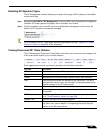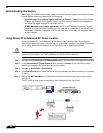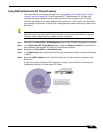
SonicPoint > RF Analysis
592
SonicOS 5.8.1 Administrator Guide
The RF Environment
The IEEE 802.11maintains that devices use ISM 2.4 GHz and 5GHz bands, with most of the
current deployed wireless devices using the 2.4 GHz band. Because each channel occupies
20MHz wide spectrum, only three channels out of the 11 available are not overlapping. In the
United States, channel 1, 6, and 11 are non-overlapping. In most cases, these are the three
channels used when deploying a large number of SonicPoints.
Figure 46:1 SonicPoint Manual Channel Selection
The whole 2.4GHz band is segmented into three separate channels 1, 6, and 11. To achieve
this ideal scenario, two factors are necessary: channel allocation and power adjustment. In
most scenarios, it’s best to assign neighboring SonicPoint appliances to different channels.
SonicPoint transmit power should also be watched carefully, as it needs to be strong enough
for nearby clients to connect, but not so powerful that causes interference to other SonicPoints
operating within the same channel.
Using RF Analysis on SonicPoint(s)
RFA uses scores, graphs, and numbers to assist users to discover and identify potential or
existing wireless problems.
Although the best case scenario is to have the smallest number of APs working in the same
channel at any given time, in the real world it is difficult to maintain that especially when
deploying large amount of APs. Also, since the ISM band is free to the public, there may be
other devices operating that our out of immediate control of the network administrator.
• “Channel Utilization Graphs and Information” section on page 593
• “Making Sense of the RF Score” section on page 594
• “Viewing Overloaded Channels” section on page 594
• “RFA Highly Interfered Channels” section on page 595
p_
Channel 1 Channel 6 Channel 11 Channel 1
Channel 6Channel 1Channel 11


















